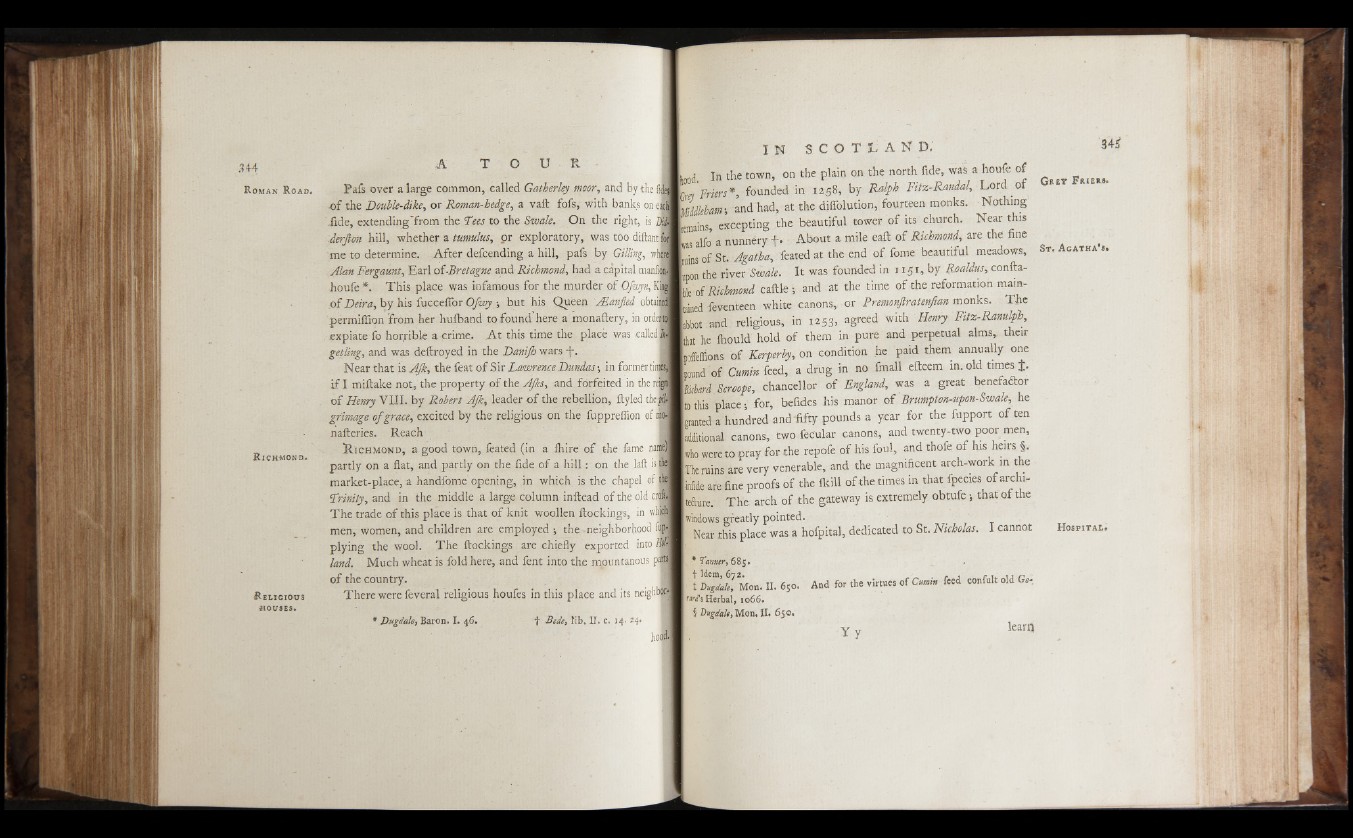
R om an R o a d . Pafs over a large common, called Gather ley moor, and by the fJ
■of the Double-dike, or Roman-hedge, a vaft fofs, with b an k s on eJ
.fide, extending'from the Tees to the Swale. On the rig h t, is D?
derfion hill, whether a tumulus, pr exploratory, was to o diilant foi
me to determine. After defcending a hill, pafs by Gilling, whir
Alan Fergaunt, Earl of-Bretagne and Richmond, had a c ap ital manfif
houfe *. This place was infamous for the murder o f Ofwyn,YM
of Deira, by his fucceffor Ofwy-, but his Queen ASanfled obtaiF
perrniffion 'from her huiband to found'here a monaftery, in ordeffl
. expiate fo horrible a-crime. At this time the place was callediiij
getting, and was deftroyed in the Danijh wars -j-.
Near that is AJk, the feat of Sir Lawrence Dundas-, in form er tiin^f
if I miftake not, the property of the AJks, and forfeited in the reign
of Henry VIII. by Robert AJk, leader o f the rebellion, ityled thtpiH,
grimage of grace, excited by the religious on the fuppreffion of mol
naileries. Reach
o R ic h m o n d , a good town, feated (in a ihire of t-he fame
partly on a flat, and partly on the fide of a h ill: on the laft isW
market-place, a handfome opening, in which is the chapel of M
Trinity, and in the middle a large column inftead of the old crofil
The trade of this place is that of knit woollen ftockiogs, in wqic.hj
men, women, and children are employed ; the .neighborhood M
plying the wool. The (lockings are chiefly exported into
land. Much wheat is fold here, and fent into the mountanous paii
of the country.
R e l i g i o u s There were feveral religious houfes in this place and its neighW
-HOUSES.
* Diigdale, Baron. I. 46. 4 Bede, fib. II. c. 14- 24.
bool
a In the town, on the plain on the north fide, was a houfe of
fry. Friers*, founded in 1258, by Ralph Fitz-Randal, Lord of
Udkham; and had, at the diffolution, fourteen monks. ^Nothing
bains, excepting ,the beautiful tower of its church. Near this
U alfo a nunnery f • About a mile eaft of Richmond, are the fine
Lins of St. Agatha, feated at the end of fome beautiful meadows,
Lon the river Swale. It was founded in 1151, by Roaldus, confta-
Ce of Richmond cailk | and at the time of the reformation maintained
feventeen white canons, or Premonjlratenfian monks. The
Lot and religious, in 1253, agreed with Henry Fitz-Ranulph,
Lt he ihould hold of them in pure and perpetual alms,, their
Lfleilions of Kerperby, on condition he paid them annually one
Lund of Cumin feed, a drug in no fmall efteem in. old times j\
Mard Scroope, chancellor of England, was a great benefaftor
'to this place; for, befides his manor of Brumpton-upon-Swale, he
«anted a hundred and-fifty pounds a year for the fupport often
additional canons, two fecular canons, and twenty-two poor men,
who were to pray for -the repofe of his foul, and thofe, of his heirs §.
l:The ruins are very venerable, and the magnificent arch-work in the E£ are fine proofs of the iltill of the times in that fpecies ofarchi-
tefture. The arch of the gateway is extremely obtufe •, that of the
windows greatly pointed.
Near this place was a hofpital, dedicated to St. Nicholas. I cannot
* fanner, 685.
t Bu^Me, Mon. II. 650. And for the virtues o f Cumin feed confult old Ge-
fur/s Herbal, 1066.
§ Dugdale, Mon, II. 650.
G rev F r ie r s .
St . A c a t h a ’s.
H o s p i t a l .
learrj